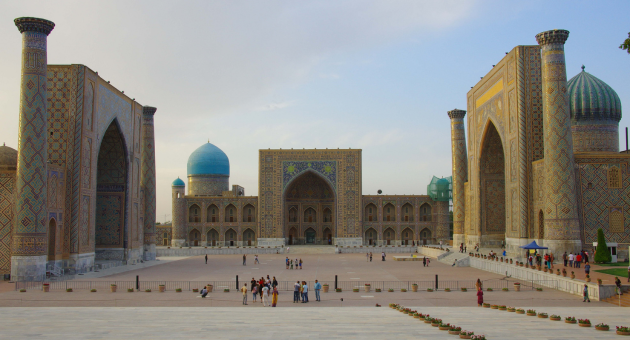Samarkand is one of the oldest cities in Central Asia, with a rich history spanning thousands of years. A journey through this ancient city will take you on a captivating adventure, as you unravel the stories and legends that have shaped it over time.
From early beginnings to the Golden Age under the Timurid Dynasty, Samarkand played a significant role in the development of trade, culture, and religion in the region.
The Rich History of Samarkand

The Early Beginnings of the City
The earliest records of Samarkand date back to the 7th century BC, when the Sogdians, an Iranian people, inhabited it. The city was strategically located on the Silk Road, a major trading route between China and the Mediterranean, which facilitated the exchange of goods, ideas, and cultures.
Samarkand’s importance grew under the Persian Empire, which conquered the city in the 6th century BC. The Persians built impressive structures, such as the Cyrus Palace, which served as a royal residence and an administrative centre.
The Impact of Alexander the Great
Alexander the Great conquered Samarkand in 329 BC, after a fierce battle against the Sogdians. He was impressed by the city’s beauty and strategic location and decided to make it one of his military outposts. Alexander’s conquest paved the way for Hellenistic culture to spread in the region, as Greek language, philosophy, and art influenced local traditions.
The Golden Age under the Timurid Dynasty
The Timurid Dynasty, led by the renowned warrior and patron of arts Timur, ruled Samarkand from the 14th to the 16th century. During this period, the city experienced a cultural renaissance, as Timur and his descendants commissioned grand buildings, such as the Registan complex, the Gur-e Amir mausoleum, and the Bibi-Khanym mosque. These structures were adorned with intricate tilework, calligraphy, and geometric patterns, reflecting the mastery of Islamic art and architecture.
The Silk Road and its Influence on Samarkand
The Silk Road played a significant role in the development and prosperity of Samarkand. Traders from China, India, Persia, and Europe brought exotic goods such as silk, spices, and precious stones to the city, which became a centre of commerce and innovation. The exchange of goods and ideas also led to the cross-fertilization of cultures, as Samarkand absorbed and adapted foreign traditions, religions, and languages.
Architectural Wonders of Samarkand

The Registan: A Majestic Public Square
The Registan, or “Sandy Place,” is a UNESCO World Heritage Site and one of the most iconic landmarks of Samarkand. It comprises three madrasahs, or Islamic schools, built in different periods: the Ulugh Beg Madrasah (1417-1420), the Tilya-Kori Madrasah (1646-1660), and the Sher-Dor Madrasah (1619-1636). The madrasahs are adorned with intricate mosaics, carvings, and domes, and feature spacious courtyards and classrooms.
The Gur-e Amir Mausoleum: A Timurid Masterpiece
The Gur-e Amir Mausoleum is where Timur and his descendants are buried. It was built in the early 15th century by Timur’s grandson, Ulugh Beg, and features a majestic dome, a spacious hall, and ornate marble decorations. The mausoleum is considered a masterpiece of Timurid architecture and inspired similar structures in Iran and India.
The Bibi-Khanym Mosque: A Monumental Place of Worship
The Bibi-Khanym Mosque was built in the 14th century by Timur in honour of his favourite wife, Bibi-Khanym. It was one of the largest mosques in the world at the time and features a massive entrance portal, towering minarets, and intricate tilework. Despite his grandiose ambitions, Timur had to cut corners in the construction, and the mosque suffered significant damage over time. It was restored in the 20th century and still impresses visitors with its scale and beauty.
The Shah-i-Zinda Necropolis: A Sacred Pilgrimage Site
The Shah-i-Zinda Necropolis is a complex of mausoleums and tombs, built over several centuries and dedicated to various members of the Timurid dynasty. “Shah-i-Zinda” means “living king,” and refers to a legend that a cousin of the Prophet Muhammad was buried there. The complex is a sacred pilgrimage site for Muslims and attracts visitors from all over the world for its exquisite tilework, calligraphy, and decoration.
The Culture and Traditions of Samarkand

The Unique Blend of Persian and Turkic Influences
The culture of Samarkand reflects the diverse influences and encounters that shaped its history. Persian and Turkic traditions blend harmoniously in music, dance, food, and art, creating a unique identity for the city. Samarkand’s bazaars and handicrafts, such as silk weaving, metalworking, and pottery, are also renowned for their quality and beauty.
The Art of Samarkand: From Pottery to Miniature Painting
The art of Samarkand encompasses a wide range of styles and forms, from intricate miniature paintings to bold ceramics. Samarkand’s craftsmen have inherited the techniques and motifs of different cultures, and have developed their own distinctive aesthetic. The use of bright colours, floral patterns, and calligraphic script is a common feature of Samarkand’s art, reflecting the city’s vibrancy and creativity.
The Importance of Music and Dance in Local Culture
Music and dance occupy a central place in the cultural expression of Samarkand. Traditional instruments such as the dutar, a two-stringed lute, and the doyra, a frame drum, accompany lively tunes that evoke the joys and sorrows of life. Folk dances, such as the “Lazgi” and the “Beshkorpon,” feature graceful movements and colourful costumes, and reflect the spirit of community and celebration that characterizes Samarkand.
The Culinary Delights of Samarkand
Samarkand’s cuisine is a blend of Middle Eastern, Central Asian, and Indian flavours, with an emphasis on spiciness and richness.
Some of the most famous dishes are “plov,” rice pilaf with lamb, carrots, and raisins, “shashlik,” grilled skewers of meat, and “Samsa,” savoury pastries filled with meat or vegetables. A cup of hot tea with sweets or fruit is a common way to end a meal.

Conclusion
In conclusion, Samarkand is not just a city, but a journey through time and history. From its early beginnings to its golden era under the Timurids, Samarkand has been a witness to the rise and fall of empires, trade networks, and cultural exchanges.
Its architectural wonders, unique culture, and culinary delights offer a glimpse into the richness and diversity of Central Asia. A visit to Samarkand is a feast for the senses and a lesson in humanity and resilience.


